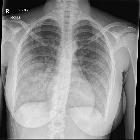Lungenblutung

Diffuse
alveoläre Hämorrhagie unter INR Entgleisung in der Computertomografie: Lungenfenster, links 3 Schichten axial, rechts oben koronar, rechts unten sagittal.

Pulmonary
hemorrhage • Traumatic pulmonary hemorrhage (gross pathology) - Ganzer Fall bei Radiopaedia

Pulmonary
hemorrhage • Pulmonary hemorrhage - Ganzer Fall bei Radiopaedia

Crazy paving
• Diffuse pulmonary hemorrhage - Ganzer Fall bei Radiopaedia

Pulmonary
hemorrhage • Pulmonary hemorrhage - Ganzer Fall bei Radiopaedia

Diffuse
pulmonary hemorrhage • Diffuse alveolar hemorrhage - Goodpasture syndrome - Ganzer Fall bei Radiopaedia

Pulmonary
hemorrhage • Pulmonary hemorrhage - Ganzer Fall bei Radiopaedia

Lungenkontusion
mit diffusen Einblutungen rechts mehr als links und schmalem Seropneumothorax bzw. Hämatopneumothorax beidseits.

Young adult
with chronic cough and hemoptysis. CXR AP and lateral show bilaterally hyperexpanded lungs with a coarse interstitial pattern, bronchial wall thickening and bilateral lower lobe bronchiectasis. The opacity in the medial aspect of the right lower lobe was new when compared to prior serial CXRs.The diagnosis was cystic fibrosis with new pulmonary hemorrhage in the right lower lobe.
Pulmonary haemorrhage is a rather broad term given to describe any form of bleeding into the lung and can arise from a myriad of causes. In a very traditional sense it is described when the following constellation of clinico-radiological features occur simultaneously (although this is never an absolute necessity):
- haemoptysis
- anaemia
- air space opacities on imaging
Pulmonary haemorrhage can be arbitrarily divided into two broad groups and several subtypes
- diffuse pulmonary haemorrhage (DPH)
- localised pulmonary haemorrhage
See also
Siehe auch:
- Lungenkontusion
- vaping-induced acute lung injury (EVALI)
- Goodpasture-Syndrom
- diffuse Alveolarblutung
- diffuse Lungenblutung
- air space opacities
- fokale Lungenblutung
und weiter:
- Konsolidierung der Lunge
- acute respiratory distress syndrome (ARDS)
- verdickte interlobuläre Septen
- angioinvasive pulmonale Aspergillose
- Melting ice cube sign (lungs)
- Milchglasherd
- differential of chronic alveolar opacities
- adult chest radiograph common exam pathology
- Surfactant-Mangelsyndrom
- medikamenteninduzierte Pneumonitis
- transbronchiale Zangenbiopsie
- acute bilateral airspace opacification
- acute unilateral airspace opacification
- Löffler-Syndrom
- Extrakorporale Membranoxygenierung
- Schmetterlingskonfiguration von Lungenverdichtungen
- Acute Respiratory Distress Syndrome neonatal

 Assoziationen und Differentialdiagnosen zu Lungenblutung:
Assoziationen und Differentialdiagnosen zu Lungenblutung:



